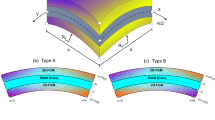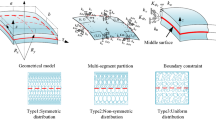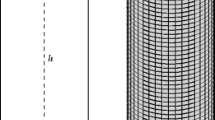Abstract
Existing models for the morphing concept of fish bone active camber (FishBAC) rely on several simplifying assumptions, hindering the accurate evaluation of its static and dynamic response. This study proposes a general framework according to which the theory of shallow shells and the Rayleigh–Ritz method are combined with artificial springs to present a basis for the dynamic evaluation of FishBAC, focusing on the free-vibration behavior as a first step for such objectives. A comprehensive code, which considers any desired boundary conditions, is written in Wolfram Mathematica to obtain the frequency parameter. After establishing the validity of the formulation through a set of comparisons with other articles and methods, a few FishBACs based on NACA 4412 are examined. Partitioning the structure and using the dimensions of these sections as the input yield accurate results compared to the finite element findings in COMSOL Multiphysics in an eigenfrequency analysis. The findings also show the notable error of neglecting the existence of curvature in the mean camber line of the trailing edges of airfoils or the span of wings based on FishBAC.






Similar content being viewed by others
Data availability
All data generated or analyzed during this study are included in this published article.
Code availability
Not applicable.
References
Ajaj RM, Parancheerivilakkathil MS, Amoozgar M, Friswell MI, Cantwell WJ (2021) Recent developments in the aeroelasticity of morphing aircraft. Prog Aerosp Sci 120:100682. https://doi.org/10.1016/j.paerosci.2020.100682
Bishay PL, Finden R, Recinos S, Alas C, Lopez E, Aslanpour D et al (2019) Development of an SMA-based camber morphing UAV tail core design. Smart Mater Struct 28(7):075024. https://doi.org/10.1088/1361-665X/ab1143
Kose O, Oktay T (2020) Simultaneous quadrotor autopilot system and collective morphing system design. Aircr Eng Aerosp Technol 92(7):1093–1100. https://doi.org/10.1108/AEAT-01-2020-0026
Klimczyk WA, Goraj ZJ (2018) Analysis and optimization of morphing wing aerodynamics. Aircr Eng Aerosp Technol 91(3):538–546. https://doi.org/10.1108/AEAT-12-2017-0289
Dimino I, Andreutti G, Moens F, Fonte F, Pecora R, Concilio A (2021) Integrated design of a morphing winglet for active load control and alleviation of turboprop regional aircraft. Appl Sci 11(5):2439. https://doi.org/10.3390/app11052439
Sun J, Guan Q, Liu Y, Leng J (2016) Morphing aircraft based on smart materials and structures: a state-of-the-art review. J Intell Mater Syst Struct 27(17):2289–2312. https://doi.org/10.1177/1045389X16629569
Chu L, Li Q, Gu F, Du X, He Y, Deng Y (2022) Design, modeling, and control of morphing aircraft: a review. Chin J Aeronaut 35(5):220–246. https://doi.org/10.1016/j.cja.2021.09.013
Sales TdP, Rade DA, Inman DJ (2020) A morphing metastructure concept combining shape memory alloy wires and permanent magnets for multistable behavior. J Braz Soc Mech Sci 42(3):122. https://doi.org/10.1007/s40430-020-2202-0
Gu X, Yang K, Wu M, Zhang Y, Zhu J, Zhang W (2021) Integrated optimization design of smart morphing wing for accurate shape control. Chin J Aeronaut 34(1):135–147. https://doi.org/10.1016/j.cja.2020.08.048
Wang S, Zhao F, Zhou B, Xue S (2021) Modeling mechanical behavior of distributed piezoelectric actuators for morphing wing applications. Multidiscip Model Mater Struct 17(6):1093–1107. https://doi.org/10.1108/MMMS-04-2021-0069
Chillara VSC, Ramanathan AK, Dapino MJ (2020) Self-sensing piezoelectric bistable laminates for morphing structures. Smart Mater Struct 29(8):085008. https://doi.org/10.1088/1361-665X/ab9060
Perez-Sanchez V, Gomez-Tamm AE, Savastano E, Arrue BC, Ollero A (2021) Bio-inspired morphing tail for flap**-wings aerial robots using macro fiber composites. Appl Sci 11(7). https://doi.org/10.3390/app11072930
Liu T-W, Bai J-B, Li S-L, Fantuzzi N (2023) Large deformation and failure analysis of the corrugated flexible composite skin for morphing wing. Eng Struct 278:115463. https://doi.org/10.1016/j.engstruct.2022.115463
Tsushima N, Yokozeki T, Su W, Arizono H (2019) Geometrically nonlinear static aeroelastic analysis of composite morphing wing with corrugated structures. Aerosp Sci Technol 88:244–257. https://doi.org/10.1016/j.ast.2019.03.025
Wölcken PC, Papadopoulos M (2015) Smart intelligent aircraft structures (SARISTU): proceedings of the final project conference. Springer, Cham. https://doi.org/10.1007/978-3-319-22413-8
Cheung K, Cellucci D, Copplestone G, Cramer N, Fusco J, Jenett B et al (2017) Development of Mission Adaptive Digital Composite Aerostructure Technologies (MADCAT). In: 17th AIAA aviation technology, integration, and operations conference. Aerospace Research Center. https://doi.org/10.2514/6.2017-4273
Majid T, Jo BW (2021) Comparative aerodynamic performance analysis of camber morphing and conventional airfoils. Appl Sci 11(22):10663. https://doi.org/10.3390/app112210663
Rivero AE, Fournier S, Manolesos M, Cooper JE, Woods BK (2021) Experimental aerodynamic comparison of active camber morphing and trailing-edge flaps. AIAA J 59(7):1–14. https://doi.org/10.2514/1.J059606
do Prado Campos GA, Raptopoulos LSC, Dutra MS (2021) Map** and selection of profiles for morphing wing of a flap** foil. J Braz Soc Mech Sci 43(2):73. https://doi.org/10.1007/s40430-021-02800-4
Chen D, Wu Z, Dong H, Meng Y, Yu J (2023) Platform development and gliding optimization of a robotic flying fish with morphing pectoral fins. Bioinspir Biomim 18(3):036010. https://doi.org/10.1088/1748-3190/acce86
Moored KW, Bart-Smith H (2006) The analysis of tensegrity structures for the design of a morphing wing. J Appl Mech 74(4):668–676. https://doi.org/10.1115/1.2424718
Woods BKS, Friswell MI (2012) Preliminary investigation of a fishbone active camber concept. In: ASME 2012 conference on smart materials, adaptive structures and intelligent systems. Stone Mountain, Georgia, USA American Society of Mechanical Engineers Digital Collection, pp. 555–563. https://doi.org/10.1115/SMASIS2012-8058
Woods BK, Friswell MI, Wereley NM (2014) Advanced kinematic tailoring for morphing aircraft actuation. AIAA J 52(4):788–798. https://doi.org/10.2514/1.J052808
Woods BK, Friswell MI (2014) Structural characterization of the fish bone active camber morphing airfoil. In: 22nd AIAA/ASME/AHS adaptive structures conference, p. 1122. https://doi.org/10.2514/6.2014-1122
Woods BK, Dayyani I, Friswell MI (2015) Fluid/structure-interaction analysis of the fish-bone-active-camber morphing concept. J Aircr 52(1):307–319. https://doi.org/10.2514/1.C032725
Rivero AE, Weaver PM, Cooper JE, Woods BK (2018) Parametric structural modelling of fish bone active camber morphing aerofoils. J Intell Mater Syst Struct 29(9):2008–2026. https://doi.org/10.1177/1045389X18758182
Schlup A, Bishay P, Mclennan T, Barajas C, Talebian B, Thatcher G, et al. (2021) MataMorph 2: A new experimental UAV with twist-morphing wings and camber-morphing tail stabilizers. AIAA Scitech 2021 Forum, p. 0584. https://doi.org/10.2514/6.2021-0584
Gudmundsson S (2013) General aviation aircraft design: applied methods and procedures. Elsevier. Amsterdam. https://doi.org/10.1016/C2011-0-06824-2
Jeffrey A (2014) Handbook of mathematical formulas and integrals. Elsevier Science, Amsterdam 10(1119/1):18427
Eschenauer H, Olhoff N, Schnell W (1996) Applied structural mechanics: fundamentals of elasticity, load-bearing structures, structural optimization. Springer, Berlin. https://doi.org/10.1007/978-3-642-59205-8
Baghaee M, Farrokhabadi A, Jafari-Talookolaei R-A (2019) A solution method based on Lagrange multipliers and Legendre polynomial series for free vibration analysis of laminated plates sandwiched by two MFC layers. J Sound Vib 447:42–60. https://doi.org/10.1016/j.jsv.2019.01.037
Ilanko S, Monterrubio L, Mochida Y (2014) The Rayleigh-Ritz Method for structural analysis. Wiley, New York. https://doi.org/10.1002/9781118984444
Mochida Y, Ilanko S (2021) On the Rayleigh-Ritz method, Gorman’s superposition method and the exact dynamic stiffness method for vibration and stability analysis of continuous systems. Thin-Walled Struct 161:107470. https://doi.org/10.1016/j.tws.2021.107470
Kim C, Dickinson S (1987) The flexural vibration of rectangular plates with point supports. J Sound Vib 117(2):249–261. https://doi.org/10.1016/0022-460X(87)90537-2
Deng J, Guasch O, Maxit L, Gao N (2023) An artificial spring component mode synthesis method for built-up structures. Int J Mech Sci 243:108052. https://doi.org/10.1016/j.ijmecsci.2022.108052
Monterrubio L, Ilanko S (2015) Proof of convergence for a set of admissible functions for the Rayleigh-Ritz analysis of beams and plates and shells of rectangular planform. Comput Struct 147:236–243. https://doi.org/10.1016/j.compstruc.2014.09.008
Leissa A, Lee J, Wang A (1983) Vibrations of cantilevered doubly-curved shallow shells. Int J Solids Struct 19(5):411–424. https://doi.org/10.1016/0020-7683(83)90052-5
Ventsel E, Krauthammer T, Carrera E (2002) Thin plates and shells: theory, analysis, and applications. Appl Mech Rev 55(4):B72–B73. https://doi.org/10.1201/9780203908723
Crossland J, Dickinson S (1997) The free vibration of thin rectangular planform shallow shells with slits. J Sound Vib 199(3):513–521. https://doi.org/10.1006/jsvi.1996.0638
Yuan J, Dickinson S (1992) On the use of artificial springs in the study of the free vibrations of systems comprised of straight and curved beams. J Sound Vib 153(2):203–216. https://doi.org/10.1016/S0022-460X(05)80002-1
Warburton G (1975) Comment on: Vibration of stepped thickness plates: By I. Chopra, Int. J. Mech. Sci. 16, 337 (1974). Int J Mech Sci 17(3):239. https://doi.org/10.1016/0020-7403(75)90056-9
Yuan J, Dickinson SM (1992) The flexural vibration of rectangular plate systems approached by using artificial springs in the Rayleigh-Ritz method. J Sound Vib 159(1):39–55. https://doi.org/10.1016/0022-460X(92)90450-C
Gould SH (2012) Variational Methods for Eigenvalue Problems: An Introduction to the Methods of Rayleigh, Ritz, Weinstein, and Aronszajn. Dover Publications, New York
Nejati M, Shokrollahi S, Cheraghi M (2024) Development of an analytical model for the flexural vibration of fish bone active camber structures with truncated, variable thickness partitions. Mech Based Des Struc 52(1):523–541. https://doi.org/10.1080/15397734.2022.2124171
Ilanko S (2012) Penalty methods for finding eigenvalues of continuous systems: emerging challenges and opportunities. Comput Struct 104–105:50–54. https://doi.org/10.1016/j.compstruc.2012.02.017
Monterrubio LE (2012) Frequency and buckling parameters of box-type structures using the Rayleigh-Ritz method and penalty parameters. Comput Struct 104–105:44–49. https://doi.org/10.1016/j.compstruc.2012.03.010
Leissa AW, Narita Y (1984) Vibrations of completely free shallow shells of rectangular planform. J Sound Vib 96(2):207–218. https://doi.org/10.1016/0022-460X(84)90579-0
Funding
Not applicable.
Author information
Authors and Affiliations
Contributions
SS, MN performed writing the draft, methodology, investigation, and administration, MC developed the formulation, numerical code, validation and review.
Corresponding author
Ethics declarations
Conflict of interest
The authors declare no competing interests.
Ethical approval
Not applicable.
Consent to participate
Not applicable.
Consent for publication
The manuscript is approved by all authors for publication.
Additional information
Technical Editor: Pedro Manuel Calas Lopes Pacheco.
Publisher's Note
Springer Nature remains neutral with regard to jurisdictional claims in published maps and institutional affiliations.
Appendix
Appendix
Different terms of Eq. 12 are delineated in what follows. The matrix \({\mathbf{C}}_{mnij,k}\) is comprised of two types of stiffness: (1) inherent stiffness of the element, and (2) the stiffness imposed by artificial springs. In its general form, \({\mathbf{C}}_{mnij,k}\) is described as
where the letter \(\text{T}\) represents the transpose, and other terms are expressed as
where Side1–4 are the numbers associated with the sides of each partition in Fig. 2b, and the recurring terms \({\mathbf{E}}_{mn}^{{\left( {r,s} \right)}}\) and \({\mathbf{F}}_{ij}^{{\left( {r,s} \right)}}\) are described as
Also, \({\mathbf{B}}_{mnij,k}\) is written as
where the matrices \({\mathbf{M}}_{k}^{UU}\), \({\mathbf{M}}_{k}^{VV}\) and \({\mathbf{M}}_{k}^{WW}\) are equally defined as
For the developed formulation in this article where the partition \(k\) is attached to the partition \(l\), the definition of the coupling matrix \({\mathbf{D}}_{mnij,kl}\) (initiating from the common side between the two partitions) is written as
where
If, according to Fig. 2a, the partition \(k\) is connected to the partition \(p\), then one can write
About this article
Cite this article
Shokrollahi, S., Nejati, M. & Cheraghi, M. Dynamic modeling of curved fish bone active camber morphing concept using shallow shell theory and negative-stiffness artificial springs. J Braz. Soc. Mech. Sci. Eng. 46, 185 (2024). https://doi.org/10.1007/s40430-023-04634-8
Received:
Accepted:
Published:
DOI: https://doi.org/10.1007/s40430-023-04634-8




